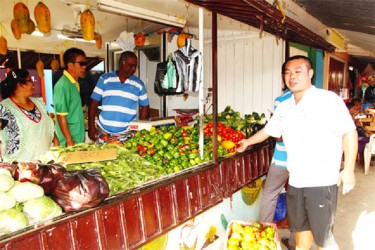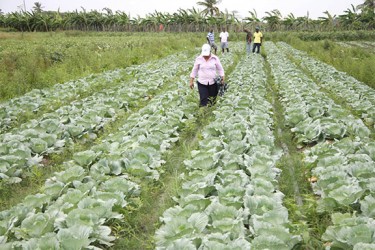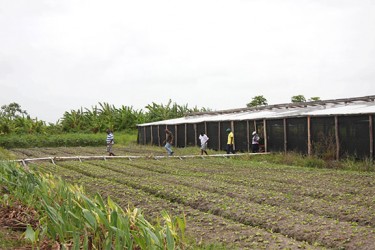Cecil ‘Sugar’ Raghoobeer and his wife Zorena have become a popular business team amongst the vendors at Mon Repos, Stabroek and Bourda markets and at several hotels in the city. Their Hope Estate Farm produces a range of fruit and vegetables which they deliver to various customers in the city and its environs in their own vans. What makes them stand out is the fact that they have married conventional farming methods with more contemporary approaches to agriculture to make their 13-acre spread a model facility.
Nor is the service they provide to market vendors and hoteliers the extent of their business venture. Their own stalls, numbers 88 and 89 on Bourda Green, are well-supported by loyal customers seeking fresh supplies of tomato, celery, cabbage, sweet pepper, hot pepper, ochro and boulanger and other vegetables and fruit.
The Raghoobeers’ venture into farming began 20 years ago with a small kitchen garden at their Industry, East Coast Demerara home. Thereafter, they graduated to bigger, though still modest farming ventures before eventually moving to Hope Estate.

Eight years ago, Raghoobeer was invited to view a shade house project on the Linden-Soesdyke Highway. Widely considered to be ideal for maximizing crop returns from farming ventures, the shade house method employs the cultivation of crops in enclosures commonly made of wooden frames and shade net or shade cloth which protects crops from excessive heat, light and dryness. It is its ability to control the exposure of crops to the elements that is making the shade house method increasingly favoured among local farmers.
Exposure to the Soesdyke-Linden Highway shade house project changed the Raghoobeers’ outlook on farming. They poured their savings into the creation of a six-acre shade house facility on their Hope Estate Farm focused on the belief that the venture would pay dividends.
Shade house farming can be a costly venture. A 450ft x 40ft shade house constructed from a local hardwood (Kabukalli is the favoured hardwood for building shade houses) and including the installation of drip irrigation for the watering and feeding of plants can cost around $1 million. At Hope Estate, the Raghoobeers operate 10 shade houses.
Then there also is cost associated with recruiting the technical expertise required to put such a project together.
Raghoobeer credits Alvin Parag, a University of Guyana Agriculture Science graduate, with providing the initial technical guidance which he required to launch his shade house project. Over time he has adapted and modernized it. More than that he has become sufficiently converted to the shade house method to have decided that over the next two years, his entire farming operation will go that route.
Raghoobeer’s pursuits are driven by the fact that the payback so far has been considerable. His vegetables are healthier, having enjoyed protection from the elements. Controlled temperature leads to more efficient growth and earlier harvesting. In effect, he is able to derive considerable market advantages associated with availability of supplies.

The Hope Estate is a visible success. It is supported by 12 farm workers, two huge pumps to supply water and about four trucks to meet the farm’s transportation needs.
Raghoobeer says his exposure to the shade house method coincided with the decision by the Government of Guyana to lease plots of land at Hope Estate. He applied and was granted a ten-year lease for the 14 acres he now occupies. Six acres are dedicated to shade house farming.
Success has bred confidence. Raghoobeer is now embarking on extending the shade house method to a further four acres in the immediate term. Additionally, he is set to venture more deeply into hydroponics, a method of cultivating plants without soil. Instead of having their roots supported and nourished by soil, the plants are supported by an inert growing medium and are fed via a nutrient-rich water solution. Growing plants hydroponically is a strategy for producing fruits, flowers, and vegetables in areas where the soil is unsuited for gardening or where space is at a premium.
At Hope Estate, Raghoobeer is also seeking to make his mark as an organic farmer. The organic method employs high quality compost and the pursuit of crop rotation in a manner that ensures maximum soil nourishment and optimum yield through rest and regeneration. Raghoobeer’s approach embraces the maxim that crops grown in healthy soil are better able to feed and protect themselves from pests and diseases. Accordingly, there is merit in not using fertilisers and pesticides.
Raghoobeer explains that while there is limited pesticide application to reduce the incidence of pests and crop diseases, this is stopped altogether about three weeks before harvesting.
In the main his soil mix comprises burnt paddy husk acquired from rice mills. There is no cost to the burnt paddy husk but labourers must be paid to pack the material onto trucks. Fuel for the trucks is an additional cost. At the farm the husk is liquefied and fed to the plants through a drip irrigation system. Drip irrigation lasts three hours and costs are saved since the method allows water to drip slowly to the roots of plants, either (onto the soil surface or directly onto each root) through a network of pipes and valves thereby reducing the volume of water used.

On the ground, plant beds are elevated to prevent water logging. It is one of those details to which Raghoobeer has learnt to pay attention.
Each week the Raghoobeers harvest between 2,000 and 3,000 pounds of sweet pepper, ochro, cabbage and tomato. After reaping, the produce is crated and transported to the vendor outlets in the various markets and to the hotels. Some of the produce is also taken to the Raghoobeers’ Bourda Green stall.
When Stabroek Business visited the stall last Friday afternoon the Raghoobeers were offering ochro at $80 a pound; sweet pepper at $460 a pound and cabbage at $260 a pound. Papaya was also on sale at prices beginning at one $150.
Raghoobeer said that his own lower costs of production meant his pricing could help set prices in the market. There are times, however, when a glut on the market sends prices tumbling. At those times “you have to be prepared to take some losses,” he said. This is the case with pepper which is currently being retailed at around $60 a pound. Raghoobeer told Stabroek Business that he has delayed cutting down a crop of pepper based on indications that prices could rise again. He estimated that at the current price 100 pounds of pepper will bring earnings of around $6,000. “It will cost $4,000 to pick that pepper; $2,000 [profit] doesn’t make a great deal of sense. That is not even sufficient to purchase manure. In those cases it’s better to leave the pepper on the trees,” he said.
For now at least Raghoobeer is indifferent to the export market. “Not even if I am paid more,” he quips. He gives no reason though he says he is “more than happy” with the extent of his local clientele and the fact that the quality of what he offers keeps his customers coming back.
Zoreena, who runs the Bourda Green stall said that “on a good day” most of what is brought to market is sold by 10:00hrs. The stalls are distinctively tiled in white and boast a freezer where some of the vegetables are stored. The scales bear the approving mark of the Guyana National Bureau of Standards.
The trucks used to transport the vegetables are air-conditioned, a development which, Raghoobeer said is designed to ensure that the produce is delivered to market in a presentable state. The standards he boasts are impressive. His farm boasts a low labour turnover. The efforts of his farm hands are mitigated by pieces of modern machinery including a tiller. His use of the drip method means that there is no energy and time-consuming watering process. Likewise, there is no labour-intensive fertilising exercise.
At the Raghoobeers’ Hope Estate Farm there is no extended period of toiling in the sun or rain. “I pay well too,” Raghoobeer said, a mischievous smile lighting up his face. These days, he said, are a long way from the time when he and his wife commenced farming at Hope Estate. Back then, he said, they were making just sufficient to run their home. What exists today is a manifestation of almost ten years of saving. He recalled that much of his first makeshift shade house was constructed out of old wood and disused plastics. These days he runs ten well-constructed shade houses. In two weeks’ time another two will be under construction.
Crop cultivation apart, the Raghoobeers operate a nursery with around eight thousand seedlings. In two weeks’ time those will go into crop cultivation. Within a further six to ten weeks those crops will be ready.
These days Raghoobeer is touted as a ‘leading light’ in shade house cultivation. His farm is sometimes used in seed experiments. Currently, a new variety of cabbage is under trial cultivation. Sometimes he gets visits from shade house enthusiasts residing both at home and abroad. The Raghoobeers, unquestionably, have become highly visible for their work in contemporary farming techniques and they seem set to take their good fortune as far as it will go.




